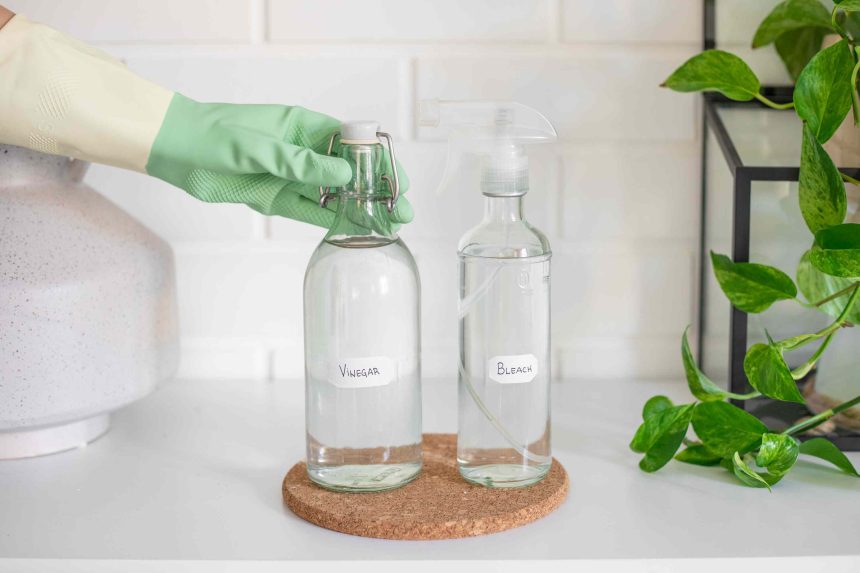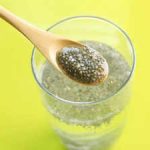When we encounter a tough-to-remove stain on a surface, our first inclination is to throw every product in the cleaning cabinet at the problem. If one product doesn’t work, we try another. Or, we decide that combining two cleaners will surely produce the results we want.
While some cleaning products like baking soda and distilled white vinegar can be safely mixed, others can be deadly. Two products that work very well alone, vinegar and chlorine bleach, are highly toxic when combined.
Meet the Expert
Anne Marie Helmenstine, PhD is a chemistry expert at Thought Co.
What Happens When Vinegar and Chlorine Bleach Are Combined
The Spruce / Sanja Kostic
Chlorine bleach is a strong oxidizer that makes a highly effective disinfectant and stain remover. Its active ingredient is sodium hypochlorite. The bottle of chlorine bleach you bring home contains sodium hypochlorite dissolved in water, creating hypochlorous acid.
The distilled white vinegar you see in the condiment aisle contains around five percent acetic acid and 95 percent water. Cleaning vinegar contains around six percent acetic acid or is 20 percent stronger.
According to Thought Co.’s chemistry expert, Anne Marie Helmenstine, PhD, if you mix chlorine bleach with another acid, this reaction occurs and toxic chlorine gas is formed. The reaction is usually silent until you smell the fumes and begin to have negative effects.
Pure chlorine gas is greenish-yellow in color, but because the household ingredients are usually diluted, the gas is invisible.
Want more cleaning and organizing tips? Sign up for our free daily newsletter for the latest hacks, expert advice, and more!
What to Do After Exposure to Chlorine Gas
The Spruce / Sanja Kostic
- Immediately leave the area where the exposure occurred.
- If possible, increase the ventilation in the area by opening windows and doors.
- If the gas is inhaled and symptoms appear, contact emergency services, a healthcare advisor, or your local Poison Control Center for care instructions.
Other Combinations to Avoid
In addition to chlorine bleach, vinegar should never be combined with hydrogen peroxide. The combination creates peracetic acid, a corrosive and irritating substance.
Combining chlorine bleach with any acid, not just vinegar, can produce toxic gases. Products containing acids include some brands of glass and window cleaners, automatic dishwasher detergents and rinses, toilet bowl cleaners, drain cleaners, rust removal products, and brick and concrete cleaners.
Combining chlorine bleach and ammonia forms chloramine gases, also highly toxic. In addition to household cleaning ammonia, ammonia can be found in some glass and window cleaners, interior and exterior paints, and urine. Use caution when using chlorine bleach to clean litter boxes, diaper pails, or toilet bowls.
How to Avoid Problems With Cleaning Products
The Spruce / Sanja Kostic
- Store all cleaning products in their original containers.
- If you have transferred a cleaning product to a new spray bottle, label the contents clearly.
- Store cleaning products that can have negative reactions when combined in separate areas.
- Store all cleaning products in a cool, dry location out of the reach of children, pets, and vulnerable adults.
- Read product labels and follow directions carefully. Call the manufacturer or consult their website if you have any questions about ingredients or usage.
- Use only the recommended amount of any cleaner.
- Increase ventilation in small areas by opening doors and windows or adding a circulating fan before cleaning with any product.
- Wear protective gloves, clothing, and eyewear.
- Rinse surfaces and flush drains completely with clean water before switching to another type of cleaner.
- Know what to do if there is an emergency.
- Wash your hands after using cleaning products and before eating or drinking.
- Dispose of cleaners that have not been used within the last year. Their chemical stability may be compromised.







